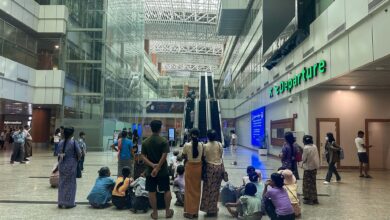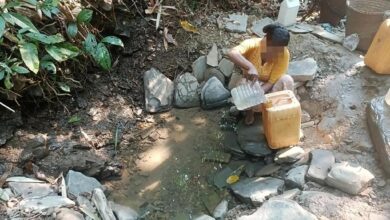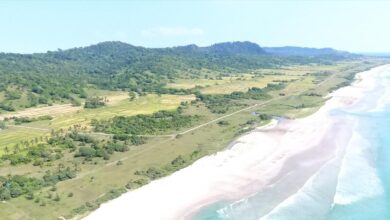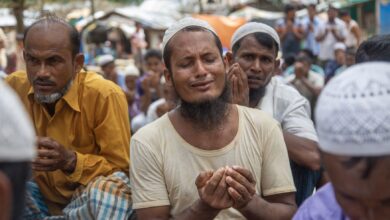
Warning: This story contains graphic descriptions of violence.
Sandar Win was alone when a group of armed men took her from her home on the night of September 14.
It was an unusual place for her to be. She had only returned because she wanted to plant some teak trees on her family’s land near Taung Bet, a village in Magway Region’s Pauk Township, early the next morning.
She had been staying away to protect her family. As a supporter of an anti-regime resistance group called the Southern Pauk Guerrilla Force (SPGF), she was active in raising funds for its operations. She knew that this made her a target, and she didn’t want to put her children in harm’s way if the junta ever tracked her down.
After an attempt to flee through a back window, Sandar Win went away with the men who came for her late that night. Her husband, who was staying at another house nearby, said that her captors did not handcuff her or tie her up; he took this as a good sign. Hours later, however, he heard a gunshot that made him fear the worst.
Their neighbours were not sure what to make of the sound.
“We heard the gunshot after her arrest, but we just assumed it was a soldier firing off a random shot, as usual,” said one.
A gruesome discovery
Before dawn the next morning, Sandar Win’s husband went into the village to let their friends know what had happened. Some went to the local police station to try to get some information, while others formed into search parties.
Armed with flashlights, they scoured a wooded area on a hill about half a kilometre north of the village, known as “tower hill” because of the telecoms tower located there.
Her brains were spilling out. She had been shot in the back of the head and her face was flat on the ground
The search began at around 5am. It was slow going. It had started to rain, so any footprints made the night before had been washed away. After more than two hours, they took a short break. About an hour after they resumed their search, they finally found her, lying face down in the mud.
“Her brains were spilling out. She had been shot in the back of the head and her face was flat on the ground. It looked like she had been dragged there, as there was a trail of blood and grey matter leading up to her body. All of her teeth had been blown out, too,” said a relative who had joined the search.
Fearing that her killers would return to take away the body, they immediately carried it back to the village to be cremated.

Her husband, who had stayed behind with their distraught children—two sons aged 11 and 15, and a 13-year-old daughter—managed to attend his wife’s brief funeral, but then took his family into hiding. It wasn’t until a month later that they were able to make an offering to the monks in her memory.
The villagers spared him the details of Sandar Win’s murder, including the evidence of torture that they found when they examined her body more closely.
“All they said was that she was lying face down when they found her,” said one man, who recalled that the 42-year-old Sandar Win often said that she was not afraid to die.
“All she wanted was to live long enough to see the revolution succeed,” he added.
A witness to murder
In mid-October, a young cowherd named Swe Maung Oo was detained and interrogated by members of a local resistance group. From him they learned about the operations of regime forces in the area, and also about the activities of the shadowy Pyu Saw Htee militia group.
Five videos seen by Myanmar Now show two PDF members kicking and punching the blindfolded 23-year-old as others question him about these “operations”—including the one targeting Sandar Win.
Swe Maung Oo—who told his captors that he had taken part in a 14-day training program organized by Pyu Saw Htee—said that 17 members of the group were involved in Sandar Win’s murder, along with three police officers, including the deputy chief of police from the village of Kaing Lel, Yar Zuu Maung.
He identified two men as the Pyu Saw Htee ringleaders: a 40-year-old middle-school teacher named Maung Oo and another man named Ba Thein, from the village of Ywar Thit.
They cut off her breasts before they killed her
Zaw Win, a military informant from another nearby village, set the events leading up to Sandar Win’s death in motion by pointing out where she lived, according to Swe Maung Oo. But it was Min Khaing, a Pyu Saw Htee member from the village of Pintaung, who finished the job by putting a bullet in her head, he said.
Before she reached that brutal end, however, Sandar Win was made to suffer for her crime of supporting the anti-regime resistance.
“They cut off her breasts before they killed her,” said Swe Maung Oo, shaking with fear as his interrogators pushed him to reveal everything he knew about the events of that night.
According to the terrified captive, Maung Oo, the Pyu Saw Htee leader, was the one who meted out this sadistic “punishment” on Sandar Win. For this, and for his role in orchestrating her murder, he was handsomely rewarded, Swe Maung Oo added.
In addition to two gold bracelets and some other jewellery that they also took, the men who raided her home found about 18m kyat—roughly $10,000—in cash. According to Swe Maung Oo, this money, donated by local people in support of the SPGF, was distributed among Sandar Win’s captors: 380,000 kyat (about $215) for each Pyu Saw Htee member, and the rest divided evenly between Maung Oo and Yar Zuu Maung.
Myanmar Now attempted to contact Maung Oo and Yar Zuu Maung, as well as others named in the videos of Swe Maung Oo’s interrogation, but was unable to reach them for comment.
Back from the dead
In 1952, a new militia group emerged that soon earned a reputation for ruthlessness and senseless killing. That group was called Pyu Saw Htee, and like today’s incarnation, it was tasked by the military with terrorizing civilians into submission.
The military revived the Pyu Saw Htee earlier this year to counter the massive uprising that it provoked when it seized power in February.
In Sagaing and Magway regions, where both the armed resistance movement and pro-regime forces exert strong influence, it has grown in strength especially since late June, according to people from both sides of the conflict.
Despite its clear ties to the group, the junta’s chief spokesperson, Gen Zaw Min Tun, told reporters at a press conference on September 15 that the regime did not have a hand in bringing Pyu Saw Htee back to life.
Recruitment is generally from areas known to support the pro-military Union Solidarity and Development Party (USDP). Junta authorities play an active role in finding new members.
Win Htein, a member of both the USDP and the Pyu Saw Htee, said that in early June, the central police station in the town of Gangaw contacted the administrator of his home village to request the names of active and reserve members of the group.
Zee Taw, the village in Magway’s Gangaw Township where Win Htein was recruited, is widely regarded as a Pyu Saw Htee stronghold.
“I only joined the group because they [resistance forces] kept killing people in other villages who they accused of being military informants. They even defamed our village, calling it ‘the Pyu Saw Htee village’ online. I got scared for my life, so I signed up to join the group,” he said.
Win Htein, who was among some 30 Pyu Saw Htee members who surrendered to the Yaw Defence Force (YDF) in Magway’s Htilin Township last month, said that the unit he belonged to received 40 muskets from the junta.
While many other Pyu Saw Htee members have turned themselves in to the YDF in the Yaw region, which comprises three townships—Gangaw, Htilin and Saw—the group remains powerful in Pauk, where Sandar Win was killed.
While Sandar Win was just one casualty among many who have lost their lives since the coup, her murder has had an enormous impact on the local resistance movement.
As the chief SPGF fundraiser for her area, she helped finance many of its anti-regime activities in Pauk, according to a member of the group.
“It feels like we have had our arms ripped out of our bodies, as she was our primary sponsor,” he said.



